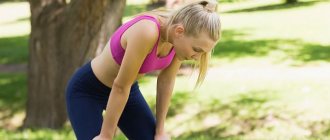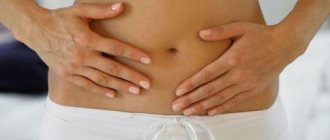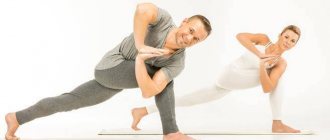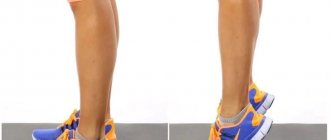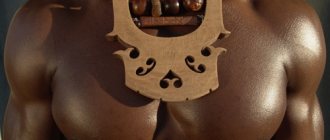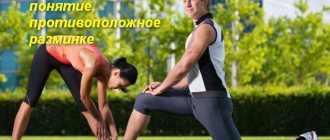A beginner comes after training with a feeling of happiness associated with the beginning of a new life in a beautiful and fit body. He feels satisfied with the work done and wants to return to the gym tomorrow, falling asleep with these thoughts.
But everything changes when a novice athlete wakes up and feels severe pain in the muscles trained the day before. Why muscles hurt after physical activity - this and other questions will be discussed in this article.
Causes
Why do muscles hurt after training? This question is often asked to the trainer by beginners who come to the gym for the first time or only work out from time to time. Krepatura is the name given to muscle pain that occurs several hours or days after physical activity. There are two main reasons for this: metabolic dysfunction and mechanical rupture of muscle cells.
According to studies conducted by employees of the Research Institute of Physical Education and Sports, pain is a consequence of destruction and micro-tears of muscle fibers. In an untrained person, the myofibrils that provide muscle contraction have different lengths. When performing exercises, especially during strength training, short myofibrils rupture.
If training is regular, the muscle myofibril cells acquire the same length, and therefore are injured to a lesser extent or not damaged at all. Over time, the muscles get used to the load, and the muscles no longer hurt as much. However, if there is a break in sports, the process of myofibril alignment resumes and the pain returns.
It should be noted that most often the muscles begin to ache on the second day, especially after the first workout. This is explained by local microinflammation in tissues that are actively being replaced by new structures. With multiple injuries received during intense training, pain is observed every other day, subsiding only by the end of the week.
At the end of the workout, protein synthesis accelerates, creatine phosphate accumulates in muscle tissue, and the level and activity of glycolysis enzymes, the process of glucose oxidation, increases. In systematically training people, glycolysis occurs almost continuously and represents a source of energy and strength necessary for full muscle contractions. Due to the regularity of exercise, depletion of the food source and energy resources is very unlikely.
Along with the energy potential of the muscles, endurance, performance and strength increase. And this is certainly good, but there is another side to the coin: a slowdown in muscle adaptation, or the so-called “training plateau.” This condition is typical mainly for bodybuilders, powerlifters and those who prefer to train with weights.
To overcome a training plateau, you need to change your training plan - for example, reducing the time between sets or doing supersets (multiple exercises without breaks). Performing supersets allows you to work several muscle groups in one approach.
Ways to prevent muscle discomfort
1. The occurrence of muscle pain is observed in beginners who expose themselves to intense exercise on the first day. Therefore, in order to prevent the occurrence of pain, it is necessary to do physical activity regularly.
2. There is a misconception that muscle pain after physical activity is normal. In fact, it is the result of an overload that the body is trying to tell us about. Therefore, you should not overload the body during the first lesson. It is necessary to increase the load gradually so that the muscles can adapt to new conditions.
Muscle pain - good or bad?
When muscles hurt after training, we can say with confidence that active healing of microtraumas is taking place. The body tries to restore damaged muscle fibers, as evidenced by pain.
However, pain is not a mandatory indicator of the effectiveness of exercise, and in some cases it can indicate pathology. The absence of pain does not mean that exercises or an incorrectly selected program are useless. At the same time, even very severe pain is not always a sign of muscle growth.
The main goal of the training should be adequate loads, which gradually and systematically increase. You can evaluate the effectiveness of exercises by visually changing the configuration of the muscle corset, which becomes larger in volume.
On average, the pain lasts no more than three days, and its nature can be called moderate. Moreover, for most people, post-workout pain is pleasant because it is comparable to a slight feeling of fatigue.
When stretching or slightly loading well-developed muscles, the pain intensifies slightly, without causing any discomfort overall. How long it will last depends on individual characteristics and sports experience. Muscles can hurt from 1-2 days to a week. In other words, moderate pain after 1 workout is more good than bad.
But it also happens differently: an unprepared person exceeds his capabilities and “goes into a rage.” This happens especially often in group classes - those who have been practicing for a long time almost always perform the exercises better than beginners. A person who comes to class for the first time tries to keep up with the others and overloads his muscles. The next day or two days later, the “overworked” beginner begins to experience difficulties with any movements, since all the muscles of the body hurt.
The formula “No pain - no growth” is the English version of the Russian proverb “You can’t pull a fish out of a pond without difficulty” and reflects the essence of the training process
Persistent pain that interferes with everyday work, including basic activities, indicates excessive load or too much weight of dumbbells, weights or weights. To avoid it, it is recommended to increase the load gradually - and then the muscular-ligamentous system will gradually get stronger and get used to it.
There is no need to skip a workout if your muscles are sore. You just need to reduce the load or weight by half, and the condition will improve by the end of the session. With the number of repetitions up to 20, a large volume of blood enters the muscles, thereby improving microcirculation and nutrition, accelerating the recovery process.
An example is squats, which were the focus of the previous workout. If you have severe pain in your hips, you should include light running in your program, which will help warm up your quadriceps, and eliminate lunges and squats.
Thus, whether it is good or bad that muscle pain appears depends on its nature. In case of severe pain, the intensity of training must be temporarily reduced.
Attention: if the muscles do not have time to recover, there will be no progress. It is also worth noting that the slogan “no pain - no gain” known to the “siloviki” does not work in the case of injuries.
Why do muscles hurt after training?
Muscle pain from exercise can be caused by a number of reasons.
All of them are divided into two types: physiological and pathological. Let's look at each type in more detail. 1. Physiological – this type includes pain after training that was not caused by injuries or concomitant diseases.
- accumulation of lactic acid in muscles
Muscle work is always an energy-consuming mechanism that requires the ATP molecule formed during the breakdown of glucose. The source of glucose formation is the polysaccharide glycogen, which is found in large quantities in muscle fibers. During training, with high physical activity, accompanied by the breakdown of glycogen, oxygen deficiency may occur, the volume of oxygen consumption during this period increases significantly. In this case, the process of glycogen processing does not proceed along the aerobic path (with breakdown into water, carbon dioxide and the formation of ATP), but along the anaerobic path. This version of the process is absolutely not beneficial for the body, because the final product of glycolysis will be lactic acid or lactate. Lactic acid settles in muscle tissue, putting pressure on nerve endings, and you suddenly realize that your legs or arms hurt after a workout. In the future, the bloodstream will cleanse the accumulated acid and remove it naturally, but this process will be preceded by unpleasant sensations.
- delayed onset muscle pain
Many athletes quite often complain of muscle pain, which occurs a day or even two days after training. What is the reason? Don’t blame lactic acid, because the body has already cleansed itself of it. The nature of the appearance of this pain is the so-called sore throat effect - microdamage to the connective structural fibers. The appearance of such tiny tears encourages the body to more actively stimulate healing functions. Inflammation caused by ruptures is what causes pain.
2. Pathological – that is, the pain from training that causes direct harm to health.
- overtraining
In pursuit of quick results, many novice athletes neglect safety rules, loading the body with training without a break. As a result, micro-tears in cells do not have time to heal, but only increase; the body, instead of sending proteins to muscle growth, engages in enhanced restoration and healing, and you lose muscle mass and experience pain.
- damage to joints, ligaments, tendons
Sharp pain coupled with an elevated temperature should not only alert you, but actively encourage you to seek medical help. Damage of this nature requires careful monitoring and therapy.
- muscle reactivity
During intense sports, the water-salt balance is disrupted, which can lead to pain and even cramps. This is why it is important to drink water during exercise to avoid dehydration.
Injuries
With mechanical damage, for example, sprains and ruptures of ligaments, acute, stifling pain occurs. It may appear at the time of injury, when the muscle is too tight, or the day after training. Such pain cannot be ignored, much less continue to exercise.
A sprain involves damage to tendons and muscles, which is accompanied by a number of symptoms:
- pain and stiffness of movement;
- increasing swelling and redness;
- the appearance of hematoma and bruising.
In case of such an injury, you should immediately stop exercising and keep your arm or leg as motionless as possible. A cold compress or ice applied in the first minutes after injury helps reduce swelling and prevents the formation of a large hematoma. In addition, cooling is a good pain reliever.
Separately, it is worth mentioning the pain during the final repetitions of the exercises. It resembles a burning sensation and occurs at the final stage, when lagging, direct muscle groups and slow fibers are worked out. This is completely normal and is explained by the body’s protective reaction against overload.
Every athlete experiences burning pain at the end of repetitions, regardless of their level of training. The reason for its appearance is the effect of lactic acid on the muscles, which fills the cells and blocks the path of nerve impulses. It is as a result of muscle oxidation that a characteristic burning sensation occurs. The breakdown products of lactic acid are eliminated from the body within half an hour after the end of the workout.
Types of muscle pain
- Moderate muscle pain.
Occurs immediately after classes. Its appearance is explained by microtraumas and excess lactic acid in the muscles. This muscle pain is quite mild. - Delayed muscle pain
. It appears a few days after exercise, most often on the second day. This severe muscle pain prevents the muscle from contracting fully. It usually occurs with very intense training in beginners without a period of adaptation to the load, as well as with too much emphasis on eccentric loads (muscle stretching when lowering weights). - Muscle pain from injury.
First sharp, then aching, constraining, aggravated by the slightest load or sudden movement. In addition, it may be accompanied by swelling and hyperemia of the damaged area. Regardless of the nature of the injury, in such cases it is necessary to consult a doctor. The most serious injuries characterized by this type of pain are muscle rupture, nerve compression, joint damage, etc.
What to do to prevent muscle pain
It is impossible to completely get rid of muscle pain after exercise, but there are ways to reduce its intensity. If the pain is caused by the accumulation of lactic acid, then warm-up exercises are the best solution. This will help remove acid from tissues as quickly as possible and improve blood circulation. For example, walking or cycling can help reduce calf pain.
A bath with hot water, to which you can add sea salt, pine extract or herbal decoction of chamomile and sage, gives a good relaxing effect. The procedure is best done immediately after training, especially if it was exhausting. A contrast shower will bring no less benefits.
Proper drinking regime is of great importance when playing any sport. You need to drink both during and after training. A constant supply of fluid to the body maintains the functioning of joints, muscles and kidneys at the proper level. In addition, lactic acid is eliminated from the body much faster.
To avoid having to relieve pain after exercise, it is recommended to do a warm-up and cool-down. This means that before performing the main block of exercises, it is necessary to carefully prepare the muscles and warm them up. And at the end, do some stretching and relaxation exercises.
When taking a contrast shower, it is not recommended to make the water too hot or too cold - the contrast should be minimal, otherwise, instead of a relaxing effect, the body receives additional stress
The main condition for the effectiveness of training is adherence to the correct technique. Ideally, the entire training process should take place under the supervision of a trainer, otherwise you need to control all movements yourself, avoiding technical errors.
It is worth noting that it is strictly not recommended to exercise on an empty stomach or, conversely, after a heavy meal. If you feel unwell or have a cold, it is best to skip training.
A balanced diet is an integral part of physical training, since with a lack of certain substances it is extremely difficult to achieve high results and avoid muscle soreness. The diet must contain sufficient amounts of proteins, carbohydrates, vegetables, fruits and herbs.
You can relieve pain with the help of a massage, which is done either by a specialist or independently, at home. A bath or sauna can also relieve pain.
How to prevent pain after exercise
Most people who play sports experience a feeling of pain after exercise - in general, this is a natural process, it does not pose a danger to humans, provided that the pain is moderate. However, there is nothing pleasant about this, and besides, sometimes the feeling of pain after training becomes strong - this can bring serious discomfort. In order to minimize pain after physical activity, you can try the following:
- Observe the correct execution of exercises. How quickly a particular muscle group is used during training determines how quickly it will develop and whether it will hurt a lot after completing the training. If a person who decides to start playing sports does not have enough knowledge regarding the correct execution of exercises, he should seek advice from someone who understands this - for example, a sports coach;
- Before starting the main part of the workout, do a warm-up. Exercises of this type are aimed at preparing the body for the upcoming increased load and not injuring it. The main task of warming up is to improve blood circulation in the body and warm it up. It helps not only to prevent the occurrence of pain after exercise, but also to increase the effectiveness of the training itself;
Read:
What do burning cheeks portend?
- If you lack strength, give up physical activity. Sports training is, one way or another, always additional stress for the body. After them, the body goes through a recovery period, during which it also expends energy. If there is a busy period at work with a minimum number of days off, and there is a catastrophic lack of sleep at night, it is better to give up classes for some time;
- Drink more water. Fluid plays a big role in the smooth functioning of the body. Insufficient intake can lead to disruption of the water-salt balance, blood thickening, and, as a result, to thrombosis. During physical exercise, the human body heats up. In order to optimize its work and normalize temperature, the body begins to produce sweat. Along with it, a person loses a large amount of water, its replenishment will have a positive effect both on minimizing pain after training and on health in general.
The occurrence of muscle pain after physical activity is considered normal. At the same time, if the pain is too strong, it is advisable for a person to postpone the workout to another day - do not overload the body. You can relieve pain with warm baths and massage. If the pain is unbearable, you should take a painkiller from the group of non-steroidal anti-inflammatory drugs - Aspirin, Nimesulide, Ibuprofen.
Medications for muscle pain
If the sensations are so painful that they are difficult to tolerate, non-steroidal anti-inflammatory drugs (NSAIDs) based on Ibuprofen or regular Aspirin are used. They should be taken only in extreme cases, since NSAIDs have a toxic effect on the gastrointestinal tract and can slow down recovery processes.
In sports medicine, various vitamin complexes are widely used to help replenish lost energy and support the body during intense physical activity.
Why does the arm hurt in the elbow joint with little load?
In addition, taking multivitamins significantly reduces muscle soreness. The most popular are:
- Aerovit (vitamins + calcium and rutin);
- Decamevit (the entire group of B vitamins + Folic acid);
- Undevit (vitamins B, C, A, P, E + Folic acid);
- Glutamevit (vitamins + Glutamic and Folic acid, iron, copper, potassium, calcium and rutin);
- Vitamin B;
- Ascorbic acid (vitamin C);
- Vitamin E.
The above vitamin complexes belong to plastic action preparations. They accelerate protein formation, restore cells and improve intracellular metabolism. Such agents as Potassium Orotate, Riboxin, Cocarboxylase (vitamin B coenzyme), Cobamamide, Carnitine, Inosine, Lipocerebrin, Silver Lecithin have a more pronounced effect.
Plastic preparations are recommended for use during increased physical activity to prevent overexertion and maintain performance.
Products containing antihypoxants and antioxidants will help you avoid fatigue and excessive fatigue after training.
Energy drugs are used to activate all vital organs and systems and increase the body's resistance to oxygen deficiency. These are Asparkam, Panangin, Calcium Gluconate and Glycerophosphate, Glutamic acid and Methionine.
Preparations from the group of adaptogens have a powerful strengthening effect, which are especially effective in unstable climates and are indicated for people experiencing high physical activity. They are made exclusively from natural products - ginseng, eleutherococcus, aralia, mumiyo, zamanikha, etc. You can drink this medicine only in the first half of the day, so as not to disturb the natural phases of night sleep.
Why does pain occur after playing sports?
The discomfort we feel 24 hours or more after exercise is called soreness, or delayed onset muscle pain syndrome. And this syndrome is the result of damage to muscle fibers caused by too intense exercise. The tiny breaks signal the immune system to release white blood cells to begin the repair process. White blood cells secrete chemicals and enzymes that doctors believe are the cause of muscle pain. And this pain is a normal reaction of the body trying to restore and strengthen tissue. It does not appear due to lactic acid, as is commonly believed, but due to microcracks in the muscle fibers that occur after intense exercise.
Experts advise that before starting an intense program with a lot of eccentric exercises with active muscle contraction, you need to do several approaches with exercises such as descending stairs.
Local agents - ointments, creams and gels
You can relieve muscle pain with the help of warming and anti-inflammatory ointments. It should be remembered that ointments or gels with warming components cannot be used in the first day or two after injuries. Painkillers or anti-inflammatory agents can only be applied to the skin if there are no open wounds.
In most cases, ointments do an excellent job of treating post-workout pain, eliminating the need to take pills. If your muscles are sore, you can treat them with one of the following remedies:
- Apizartron;
- Viprosal;
- Gymnastogal;
- Heparin ointment;
- Turpentine ointment;
- Menovazin;
- Finalgon;
- Nicoflex;
- Gevkamen.
In conclusion, it should be said that all people react differently to sports activities. Some people's muscles ache after every workout, while others almost never complain of pain. In addition, sometimes the consequences of intense training are only noticeable by mild fatigue, while a few simple exercises can cause sharp and lasting pain.
It is also worth noting that if all the rules are followed - the correct technique, normal nutrition and water regime, a well-designed training plan - excellent well-being and muscle growth are practically guaranteed.
Krepatura - good or bad?
Delayed muscle pain syndrome should not be considered a reason to stop training. On the contrary, if signs of muscle soreness appear tomorrow or the day after tomorrow, you can be sure that the body responded to unusual loads correctly and is trying to recover in all possible ways. After proper rest and bringing your condition back to normal, it is recommended to continue exercising in the gym, because the muscles have become more resilient and stronger, which means the body is ready for new achievements.
If muscle pain has not manifested itself for a long time, you should think about increasing the loads and training time, changing the program: the muscles have adapted to the same exercises, and building them up requires more tangible efforts. Performance will be higher if the training program is adjusted or changed every 2-3 months.

